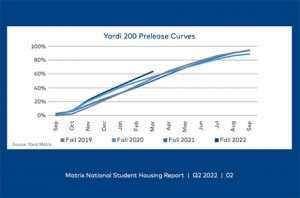SANTA BARBARA, CALIF. — The student housing industry continued to show strong fundamentals in the first quarter of this year, with preleasing levels off to a robust start and annual rent growth exceeding pre-pandemic levels, according to the latest installment of Yardi’s National Student Housing Report.
As of March, preleasing for fall 2022 was reported at 63.8 percent — a number that is 13.5 percent higher than the same time last year and 9.9 percent higher than March 2019 — and the average rent per-bedroom for fall 2022 is $777. These figures are based on the company’s “Yardi 200” markets, which include the top 200 investment-grade universities across all major collegiate conferences, including the Power 5 conferences and Carnegie R1 and R2 universities (research universities in the Carnegie Classification of Institutions of Higher Education).

As of March, preleasing for fall 2022 was reported by Yardi at 63.8 percent — a number that is 13.5 percent higher than the rate recorded at the same time last year and 9.9 percent higher than March 2019. (click on graph to see larger version)
A handful of university markets were almost fully preleased as of March, with Purdue University (99.9 percent preleased), the University of Pittsburgh (99.8 percent preleased) and the University of Wisconsin-Madison (98.3 percent preleased) topping the list. Few universities are struggling with fall 2022 preleasing so far, but those that are tend to have higher acceptance rates, according to the report. The University of Houston had the lowest percentage of bedrooms preleased in Yardi’s 200 markets at 28.6 percent, with the university accepting about 63 percent of applicants.
Rent growth
Yardi predicts another year of strong rent growth with some differentiation depending on the university level. University markets that have historically had strong preleasing and rent growth numbers are expected to continue to experience growth, but at a more moderate level, while universities that have experienced slower growth will continue to stabilize.
Fourteen universities in the Yardi 200 notched double-digit annual rent growth in the first quarter, including the University of California, Riverside with 21 percent annual rent growth; the University of Nevada, Las Vegas with 18 percent rent growth; and Wichita State University with 15.8 percent rent growth.
Only three universities tracked by Yardi had negative annual rent growth as of March: Florida International University with negative 9.6 percent rent growth; the University of South Alabama with negative 4.4 percent rent growth; and the University of California-Santa Barbara with negative 1.1 percent.
According to new forecasts released by Yardi Matrix, rent growth at its Yardi 200 universities is expected to stabilize and hover around 2 percent annual growth for the next few years.
New deliveries continue despite materials, labor shortage
Delivery of student housing projects has not slowed since the pandemic, according to the report. Nearly 26,000 beds have been completed at Yardi 200 universities over the past 12 months, and the company is forecasting just over 28,000 bedrooms coming to market this year, representing 3.7 percent of existing stock.
Yardi’s report shows 130,000 beds in various stages of development within its Yardi 200 markets with about 53,000 of those currently under construction. Most development is scattered geographically but concentrated at large universities with a high percentage of students not currently housed in residence halls or existing off-campus housing.
The University of Washington in Seattle has the most beds currently under construction with 3,476; followed by the Georgia Institute of Technology (Georgia Tech) with 3,163; The University of Texas at Austin with 2,950; the University of Michigan in Ann Arbor with 2,611 beds; and Virginia Tech University with 2,495 beds under construction.
Strong transaction volume continues
The industry is continuing to experience strong transactional volume as investors are drawn to the resiliency of the sector. The sales volume in Yardi 200 markets totaled $920 million in the first quarter, with an average sales price per-bed of about $84,000. If this rate continues, Yardi predicts that 2022 will be on pace for another record-breaking year in terms of transaction volume.
The highest level of investment this year has occurred in Sun Belt university markets, particularly in Florida. Four Florida universities made the list for highest sales volume year-to-date in 2022, with nearly $250 million in transactions in the state of Florida alone.
The top five universities with the highest sales volume were the University of South Carolina in Columbia with $136.7 million in sales year-to-date; the University of South Florida with $116.2 million; North Carolina State University in Raleigh with $64 million; Texas A&M with $60.7 million; and the University of California, Berkeley with $52.5 million in sales year-to-date.
— Katie Sloan


